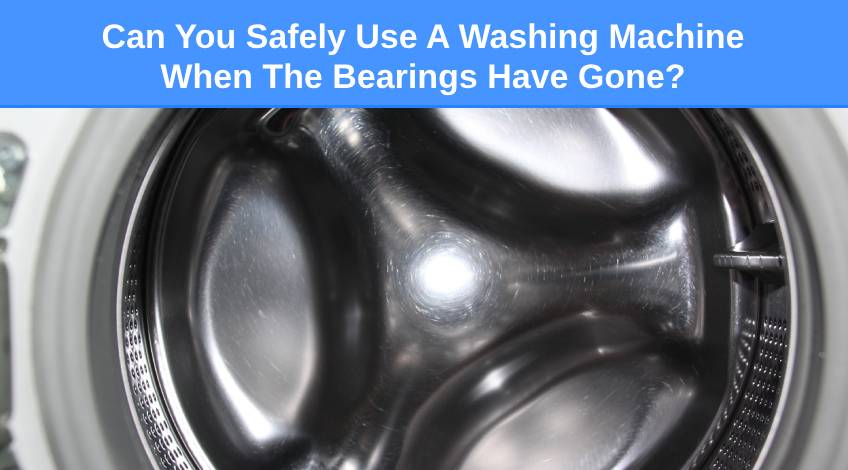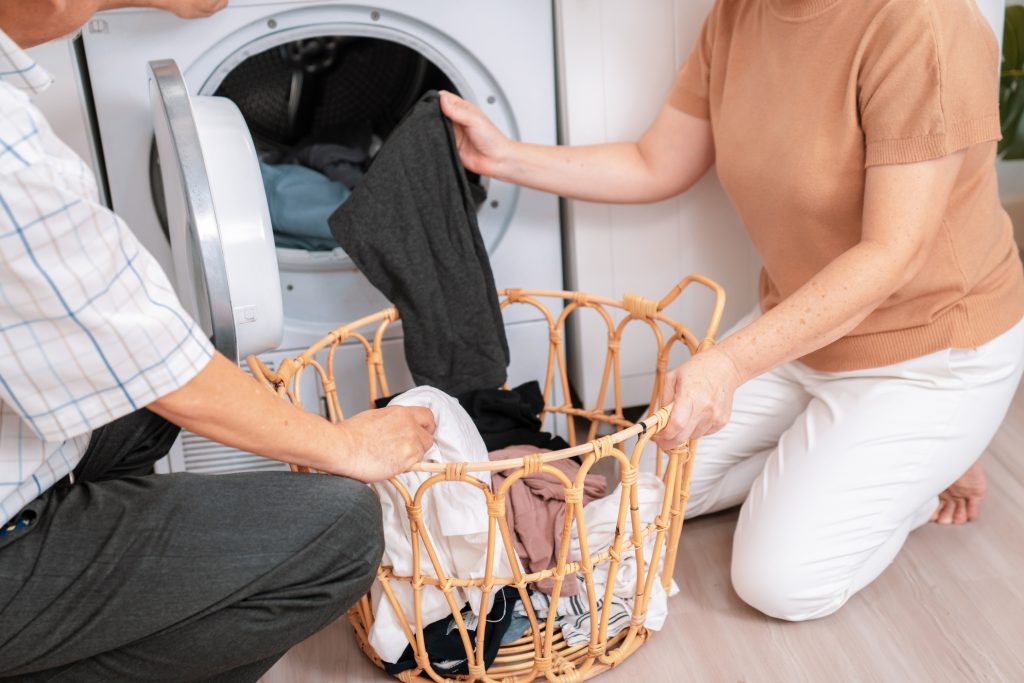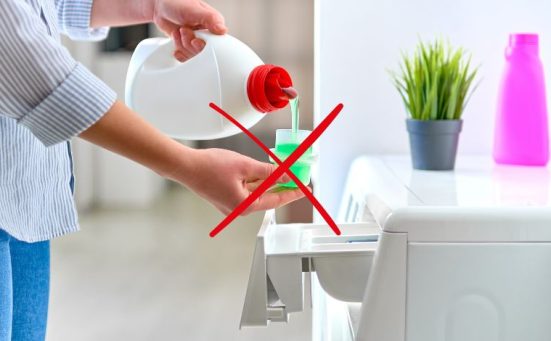
Can You Safely Use A Washing Machine When The Bearings Have Gone?
Over time, all washing machines will succumb to some sort of problems due to wear and tear. Whether this is caused by old age, planned obsolescence or a defective part, you’ll need to decide whether to keep using the washer, get it fixed immediately or replace it with a new appliance.
One of these problems is worn drum bearings. If the bearings are going on your washing machine, you’ll definitely be aware of it. Or at least that there’s something wrong with the machine.
In this article we look at how you can identify worn drum bearings, whether it’s safe to use the appliance with faulty bearings, how to replace the bearings and whether it’s worth getting the bearings on your washing machine replaced.
What Are Washing Machine Drum Bearings?
The drum bearings are an essential part of your washing machine, they ensure that the drum spins properly. They are located right in the centre of the back of the drum.
The drum bearings usually fail due to rust which is caused by the seals around the bearings leaking as they degrade usually due to old age. This allows water to seep through the seals and collect on and around the bearings.
Can The Washer Be Used Safely After The Bearings Have Gone?
It might surprise you to learn that you can technically use the washer even after the bearings have gone. However, this is not advisable as it could lead to further components breaking down as a result of the extra pressure caused by the drum being unbalanced.
This means it will save you money in the long run to get the bearings sorted before using the appliance again.
How Can You Tell That The Bearings Have Gone?
There are several tell-tale signs that the bearings have gone, or are going, on your washer. These include;
The Loud Noise It’s Making
If you’ve owned your washing machine for some time, you will be used to the sounds it makes when it’s running. If your machine has started making a different noise than usual, you’ll know that something’s wrong.
The noise of worn or damaged bearings has been described as a cement mixer on steroids, an avalanche and a jet fighter taking off. If your washer has started making a noise even slightly reminiscent of any of these descriptions, it’s most likely to be the bearings.
The Odd Motion Of The Drum
Another sure sign of a worn or damaged bearing can be seen if you look into the drum when the machine is running a wash cycle. If the inner drum is moving up and down whilst spinning, while the outer drum remains fixed into position, it’s almost certainly because the bearings have gone.
The Appearance Of Plastic Particles
If you start to find small pieces of plastic in the drum or in your laundry after washing, it’s another sign that the bearings have gone.
How To Keep Using The Appliance Even With Damaged Bearings

If you don’t have the inclination or cash to replace your washing machine, and you want to keep using your old machine, there are a few ways to keep it running for a short while.
Be aware that worn or damaged bearings can’t be mended as such, and anything you’re likely to do will still result in the bearings needing to be replaced.
Carry On Regardless
The first thing you can do is just keep on using the washer and ignore the noise (or wear earplugs). All you need to do then is wait for the inevitable to happen and hope that the machine doesn’t pack up mid wash.
Lubricate The Bearings
Another option is to lubricate the old bearings in an attempt to reduce friction and cut down on the noise. This is easy to do once you’ve accessed the drum bearings.
Unfortunately, accessing the drum bearings isn’t easy at all and entails dismantling pretty much the entire washing machine. You’ll need to remove the top panel, all of the front and rear of the washer including the control panel etc.
Then it’s just a case of removing the bearings from the drum, removing the protective cover and oil seal and then applying a manufacturer approved lubricant on the bearings.
Replace The Bearings
However, if you’re going to dismantle the appliance, you might just as well replace the bearings. The actual bearings themselves cost anywhere between £8 to £60 depending on the make and model washing machine you own.
However, taking the washing machine apart, replacing the bearings and ensuring all of the components go back together correctly is likely to take you at least 3 to 4 hours.
Even an expert will take at least a couple of hours to do this job. The cost of getting a fully qualified washing machine technician to replace the bearings will cost anywhere between £100 to £300 plus parts.
Can I Replace The Drum Bearings On A Washing Machine?
If you decide to tackle the job yourself, be warned, it’s not a job to be taken lightly and will take longer than you anticipate. Also, not all bearings can be replaced as some appliances have a sealed outer drum which makes it impossible to access the bearings.
You need to split the outer drum (many are designed to be split by undoing all of the retaining screws) to access the bearings. Some of the budget models have outer drums that cannot be split.
This means replacing the whole drum assembly which can work out almost as expensive as buying a new budget washing machine.
If your washer has a split outer drum, and you’re sure that you’re capable of carrying out the replacement yourself, take a look at this video;
Is Replacing The Bearings On A Washing Machine Difficult?
Replacing the bearings on a washing machine is the most difficult repair job you can perform on a washer. This is because you need to dismantle most of the machine to access the drum.
You will need to allow at least 3 to 4 hours to do this assuming that everything goes well and there are no unexpected problems.
How To Replace The Bearings On A Washing Machine
If you decide to replace the bearings on your washing machine yourself, you should first ensure that it really is the bearings that are the issue. Once you’re sure, you’ll need to get the correct bearings for your particular washing machine.
This means quoting your machine’s model number which can be found on the control panel, or on a rating plate inside the door, on the filter cover or on the back of the appliance.
Once you have the new bearings, you can start replacing them in your washing machine. You will need to;
- Disconnect the power and water supply
Before you start to do anything at all on the washer, you need to disconnect the plug from the wall socket or switch the circuit breaker off. Then you need to isolate the water supply, this can be done by turning off the mains supply to the household via the stopcock, or turning the tap on the inlet hose to the off position. - Gather all parts and tools needed to accomplish the job
Ensure you have a large area to work in and gather all of the parts and relevant tools necessary to replace the bearings. - Familiarise yourself with the layout
Ensure you know where the bearings are located and which other parts need to be dismantled and disassembled to access the drum and bearings. - Start dismantling the appliance
You will need to remove the top and front and back panels using a screwdriver. Then the detergent dispenser drawer, control panel and the drum all need to be removed from the machine. You will need to split the drum to access the bearings. Take care when removing wiring, connectors and piping in case of damages. - Remove and replace the bearings
You’ll need a spanner and some WD40 to remove the old bearings, once removed, clean the area with a cloth and replace the bearings with the new ones. - Reassemble the appliance
Once the new bearings have been correctly fitted, you’ll need to reassemble the washing machine. Take care to install all of the components, wires, connectors and pipes correctly. You should also replace the gasket around the outer drum to prevent any leaks. Before replacing the panelling. - Test the washer
Restore the water supply and power and run a short cycle to test that the appliance is working properly again with no leaks or loud noises.
Is It Worth Replacing The Bearings On A Washing Machine?

The answer to this question is, it depends. This is because there are certain factors that determine whether it’s worth replacing the bearings or replacing the appliance completely.
Things like;
- The age of the machine
If the machine is relatively new or just outside of the warranty period, it’s likely that the rest of the components will continue to work properly for many years to come. Especially when you consider the average lifespan of a washing machine is around 10 years. - The purchase price of the washer
If you bought a budget washing machine which cost less than around £300 it might work out better to replace the machine with a newer model than the cost of getting the bearings replaced on your existing model. - The cost of the bearings replacement
This is where it can get tricky, as we said earlier, the actual bearings can cost as little as £8 or as much as £60. Either way, that’s far cheaper than buying a new washing machine. However, once you factor in the cost of having the bearings replaced by an expert, you could be looking at the price of a new budget washing machine. Of course, if you bought an expensive machine in the first place, this doesn’t apply. - If the appliance has any other faults or problems
If you’ve noticed any leaks or squeaks etc that are not related to the bearings, it indicates that your washer might not last much longer anyway. In which case, it’s probably better to buy a new one and recycle the old washer.
Another thing worth pointing out is that just because you spend a lot of money getting your appliance repaired, doesn’t guarantee that it will last for a long time. There are plenty of other components that can and often do, break down.
However, the ultimate choice is yours. You can save money on replacing the bearings if you do it yourself, but as this is a particularly difficult task, you might not feel you have the ability.
Buying a new washer gives you some peace of mind as you will have a brand new warranty that should ensure at least a few years of trouble free laundry. Added to which, your washing machine will no longer sound like you’re on the runway of your local airport.
SEE ALSO: What Can Ruin A Washing Machine?
Frequently Asked Questions
When the bearings have gone on a washing machine it is extremely noisy. The sound is a deep rumbling sound and the noise increases during the spin cycle. It has been compared to the noise a cement mixer makes when in operation.
If you continue to use a washing machine with a bad bearing, it will eventually break down. It can also cause other components to overheat which could cause a fire.
The cost of replacing the bearings in a washing machine is anywhere between £100 to £300 plus parts and VAT.
Also, follow us on Pinterest ...



